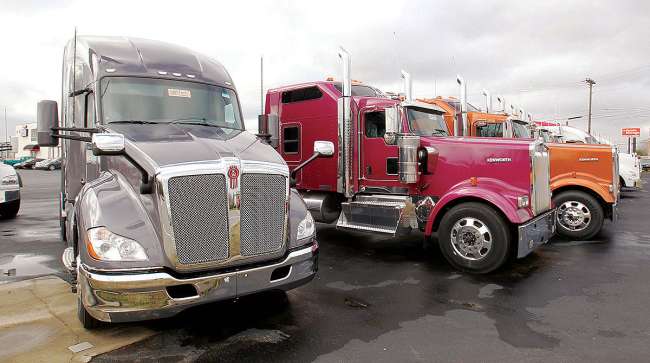Senior Reporter
October Class 8 Orders Highest in 11 Months

[Stay on top of transportation news: Get TTNews in your inbox.]
Preliminary net Class 8 orders for October, typically a bellwether month, were 22,100 and the highest in 11 months, ACT Research reported Nov 4.
A year earlier, net orders climbed to 43,256, according to ACT.
Since January, orders have failed to top 17,000 in any month, while three months stayed below 11,000 units — and analysts were looking to October as a key indicator of how Class 8 demand in 2020 would unfold.
FTR also pegged preliminary net orders at 22,100.
“It’s above 20,000, which is good because below 20,000 would have signaled a really tough time,” Don Ake, FTR’s vice president of commercial vehicles, said to Transport Topics about October’s volume. “But it is not close to 30,000, which means there are still some serious questions and serious issues about 2020.”
ACT Research: NA Medium Duty Demand Slowed, while Class 8 Order Intake Improved in Octoberhttps://t.co/ENC36KNxQO — ACT Research (@actresearch) November 5, 2019
He added: “I think the orders will stay in this range until things smooth out a bit.”
Ake also said he was hoping order cancellations in October, to be announced later in November, would be higher, “only in that it would make the net new order number look better.”
Cancellations are subtracted from gross orders to get the net number.
“[Without knowing the cancellations,] it throws a little more uncertainty onto October’s preliminary number,” Ake said.
ACT Vice President Steve Tam said ACT’s metrics point to a slight indication the industry has found the bottom of the supply-demand trough “and things are moving a little bit sideways.”
The 22,100 volume supports ACT’s outlook for where production is headed in 2020, he said. “It falls within the lines.”
ACT has forecast production would reach 345,000 this year before dropping to 238,000 next year as things currently stand, he said.
Two large publicly traded truckload carriers recently pointed to capacity leaving the market as signs industry rebalancing is underway, and said that situation will grow in the face of several challenges especially hard for smaller carriers to manage. Both carriers indicated they intended to add trucks. Their comments clearly underscored how truck orders reflect the larger conditions in the industry.
“We believe the recent combination of falling new truck orders, growing backlog of used trucks for sale, regulatory constraints and skyrocketing insurance premiums for smaller carriers, all indicate the early stages of capacity exiting the market,” U.S. Xpress Inc. CEO Eric Fuller said during a third-quarter earnings conference call.

Fuller
U.S. Xpress Enterprises, based in Chattanooga, Tenn., ranks No. 20 on the Transport Topics Top 100 list of the largest for-hire carriers in North America.
“Additionally, the federal Drug and Alcohol Clearinghouse is expected to go live in January, which we believe will be a major event for the industry and further squeeze capacity out of the market over time,” he added.
The clearinghouse rules, which take effect Jan. 6, are intended to counter job-hopping drivers who fail their drug and alcohol tests unbeknownst to their new prospective employer.
Another big factor, Fuller said, is hair follicle testing — which is seen as more accurate and can refute clean results from urinalysis. It is not approved for meeting federal screening regulations, but fleets can use it as a condition for employment.
”If you go back and look historically at our peers that went to hair follicle testing, some saw as much of a drop as 5% to some as high as 10% in their truck count for a period of quarters after they went to hair follicle testing,” he said.
“So if we were to reduce our fleet and then go to hair follicle testing and take a huge hit, then that would be a significant hit with our overall revenue, and we believe our cost infrastructure would suffer,” Fuller said. “And so by being able to boost our truck count now in anticipation and try to mitigate that loss of potential revenue and loss of coverage of our fixed-cost infrastructure, we believe is the right strategy, as we go to hair follicle testing.”

Leathers
Derek Leathers, CEO of Werner Enterprises Inc., which ranks No. 15 on the for-hire TT100, agreed that capacity is leaving, and his fleet is largely maintaining its trade cycle.
“My best guess at this point is still we’ve got a couple of quarters of uphill climbing to do where we’ve got to focus and put our heads down on costs,” he said. “We got to not take our eye off of the ball on service. We have to make sure and watch expenses, but not underinvest in our fleet.”
Leathers added he expects to maintain the average age of its trucks at 1.8 years.
Ake suggested a pickup in orders could occur in January, February and March, “which would be a different order pattern.”
“But we have seen that before when things are abnormal,” he said.
Want more news? Listen to today's daily briefing:




